W
- Waste hierarchy - Waste minimisation - WEEE directive - The Wombles
This is an index of recycling topics.
- Computer recycling - Computer technology for developing areas - Container-deposit legislation - Creative reuse
- E-Cycling (recycling of electronic components) - Electronic Waste Recycling Fee - eDay - Extended producer responsibility
- Freecycling - Front of Store Recycling - Full Depth Recycling
- Humanure
- Recycling - Recycling bin - Recycling codes - Recycling cooperative - Recycling symbol - Regiving - Retrocomputing - Reuse - Reverse logistics - Reverse vending machine
- Ship-Submarine recycling program - Single-stream recycling - SIRUM (organization) (Supporting Initiatives to Redistribute Unused Medicine)
- Thermal depolymerization - Trashware
- Waste hierarchy - Waste minimisation - WEEE directive - The Wombles

Recycling is the process of converting waste materials into new materials and objects. The recovery of energy from waste materials is often included in this concept. The recyclability of a material depends on its ability to reacquire the properties it had in its virgin or original state. It is an alternative to "conventional" waste disposal that can save material and help lower greenhouse gas emissions. Recycling can prevent the waste of potentially useful materials and reduce the consumption of fresh raw materials, thereby reducing: energy usage, air pollution, and water pollution.
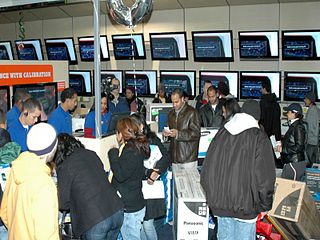
Consumer electronics or home electronics are electronic equipment intended for everyday use, typically in private homes. Consumer electronics include devices used for entertainment, communications and recreation. Usually referred to as black goods due to many products being housed in black or dark casings. This term is used to distinguish them from "white goods" which are meant for housekeeping tasks, such as washing machines and refrigerators, although nowadays, these would be considered black goods, some of these being connected to the Internet. In British English, they are often called brown goods by producers and sellers. In the 2010s, this distinction is absent in large big box consumer electronics stores, which sell both entertainment, communication, and home office devices and kitchen appliances such as refrigerators. Radio broadcasting in the early 20th century brought the first major consumer product, the broadcast receiver. Later products included telephones, televisions, and calculators, then audio and video recorders and players, game consoles, personal computers and MP3 players. In the 2010s, consumer electronics stores often sell GPS, automotive electronics, video game consoles, electronic musical instruments, karaoke machines, digital cameras, and video players. Stores also sell smart appliances, digital cameras, camcorders, cell phones, and smartphones. Some of the newer products sold include virtual reality head-mounted display goggles, smart home devices that connect home devices to the Internet and wearable technology.

The Waste Electrical and Electronic Equipment Directive is the European Community Directive 2012/19/EU on waste electrical and electronic equipment (WEEE) which, together with the RoHS Directive 2011/65/EU, became European Law in February 2003. The WEEE Directive set collection, recycling and recovery targets for all types of electrical goods, with a minimum rate of 4 kilograms (9 lb) per head of population per annum recovered for recycling by 2009. The RoHS Directive set restrictions upon European manufacturers as to the material content of new electronic equipment placed on the market.

Zero Waste is a set of principles focused on waste prevention that encourages the redesign of resource life cycles so that all products are reused. The goal is for no trash to be sent to landfills, incinerators or the ocean. Currently, only 9% of plastic is actually recycled. In a zero waste system, material will be reused until the optimum level of consumption. The definition adopted by the Zero Waste International Alliance (ZWIA) is:
Zero Waste: The conservation of all resources by means of responsible production, consumption, reuse and recovery of all products, packaging, and materials, without burning them, and without discharges to land, water or air that threaten the environment or human health.
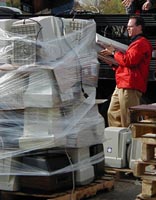
Computer recycling, electronic recycling or e-waste recycling is the disassembly and separation of components and raw materials of waste electronics. Although the procedures of re-use, donation and repair are not strictly recycling, these are other common sustainable ways to dispose of IT waste.
Reverse logistics is for all operations related to the reuse of products and materials. It is "the process of moving goods from their typical final destination for the purpose of capturing value, or proper disposal. Remanufacturing and refurbishing activities also may be included in the definition of reverse logistics." Growing green concerns and advancement of green supply chain management concepts and practices make it all the more relevant. The number of publications on the topic of reverse logistics have increased significantly over the past two decades. The first use of the term "reverse logistics" in a publication was by James R. Stock in a White Paper titled "Reverse Logistics," published by the Council of Logistics Management in 1992. The concept was further refined in subsequent publications by Stock (1998) in another Council of Logistics Management book, titled Development and Implementation of Reverse Logistics Programs, and by Rogers and Tibben-Lembke (1999) in a book published by the Reverse Logistics Association titled Going Backwards: Reverse Logistics Trends and Practices. The reverse logistics process includes the management and the sale of surplus as well as returned equipment and machines from the hardware leasing business. Normally, logistics deal with events that bring the product towards the customer. In the case of reverse logistics, the resource goes at least one step back in the supply chain. For instance, goods move from the customer to the distributor or to the manufacturer.

Electronic waste or e-waste describes discarded electrical or electronic devices. Used electronics which are destined for refurbishment, reuse, resale, salvage recycling through material recovery, or disposal are also considered e-waste. Informal processing of e-waste in developing countries can lead to adverse human health effects and environmental pollution.

Sustainable Development Strategy for organizations in Canada is about the Government of Canada finding ways to develop social, financial, and environmental resources that meet the needs of the present without compromising the ability of future generations to meet their own needs in Canada. A Sustainable Development Strategy for the organization needs to be developed that establishes the Sustainable Development goals and objectives set by the Auditor General Act of Canada and provides the written policies and procedures to achieve them. Sustainable Development is based on responsible decision-making, which considers not only the economic benefits of development, but also the short-term and long-term, Canadian environment and environmental impacts.

In 2015, 43.5% of the United Kingdom's municipal waste was recycled, composted or broken down by anaerobic digestion. The majority of recycling undertaken in the United Kingdom is done by statutory authorities, although commercial and industrial waste is chiefly processed by private companies. Local Authorities are responsible for the collection of municipal waste and operate contracts which are usually kerbside collection schemes. The Household Waste Recycling Act 2003 required local authorities in England to provide every household with a separate collection of at least two types of recyclable materials by 2010. Recycling policy is devolved to the administrations of Scotland, Northern Ireland and Wales who set their own targets, but all statistics are reported to Eurostat.
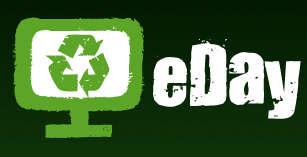
eDay was a New Zealand initiative to hold an annual ewaste collection day, started as Computer Access New Zealand (CANZ) to raise awareness of the potential dangers associated with electronic waste and to offer the opportunity for such waste to be disposed of in an environmentally friendly fashion.
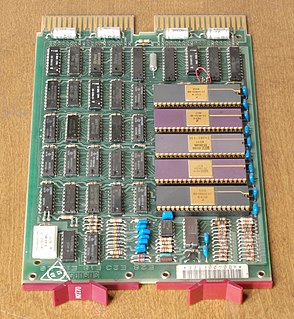
Computer hardware includes the physical parts of a computer, such as the case, central processing unit (CPU), monitor, mouse, keyboard, computer data storage, graphics card, sound card, speakers and motherboard.

Electronic waste or e-waste in the United States refers to electronic products that have reached the end of their operable lives, and the United States is beginning to address its waste problems with regulations at a state and federal level. Used electronics are the quickest-growing source of waste and can have serious health impacts. The United States is the world leader in producing the most e-waste, followed closely by China; both countries domestically recycle and export e-waste. Only recently has the United States begun to make an effort to start regulating where e-waste goes and how it is disposed of. There is also an economic factor that has an effect on where and how e-waste is disposed of. Electronics are the primary users of precious and special metals, retrieving those metals from electronics can be viewed as important as raw metals may become more scarce

Electronic waste is a significant part of today's global, post-consumer waste stream. Efforts are being made to recycle and reduce this waste.
Products made from a variety of materials can be recycled using a number of processes.

Mobile phones can be recycled at the end of their life.

As a nation, Americans generate more waste than any other nation in the world, officially with 4.4 pounds (2.0 kg) of municipal solid waste (MSW) per person per day, with another study estimating 7.1 pounds (3.2 kg) per capita per day. Fifty five percent of this waste is contributed as residential garbage, while the remaining forty five percent of waste in the U.S.'s ‘waste stream' comes from manufacturing, retailing, and commercial trade in the U.S. economy. Based on proprietary data released to the public, Nevada was named America's "Most Wasteful State" for the years 2005-2010; where each resident threw away over 14 pounds of non-recycled, unreused items, often ending up into landfills and incinerators per day, eight pounds over the national state daily throwaway average. "Wasteful" states Michigan, New Mexico, Wisconsin and Oregon as well as Washington also dominated the list's 5-year period.
Resource recovery is using wastes as an input material to create valuable products as new outputs. The aim is to reduce the amount of waste generated, thereby reducing the need for landfill space, and optimising the values created from waste. Resource recovery delays the need to use raw materials in the manufacturing process. Materials found in municipal solid waste, construction and demolition waste, commercial waste and industrial wastes can be used to recover resources for the manufacturing of new materials and products. Plastic, paper, aluminium, glass and metal are examples of where value can be found in waste.
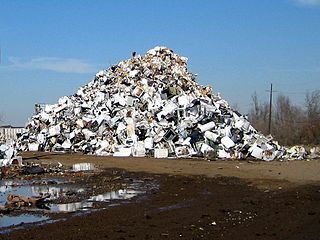
Appliance recycling is the process of dismantling waste home appliances and scrapping their parts for reuse. Recycling appliances for their original or other purposes, involves disassembly, removal of hazardous components and destruction of the equipment to recover materials, generally by shredding, sorting and grading. The rate at which appliances are discarded has increased with technological advancement. This correlation directly leads to the question of appropriate disposal. The main types of appliances that are recycled are televisions, refrigerators, air conditioners, washing machines, and computers. When appliances are recycled, they can be looked upon as valuable resources. If disposed of improperly, appliances can become environmentally harmful and poison ecosystems.
Ecomedia is a field of study that deals with the relationship between non-print media and the natural environment. Generally, this is divided into two domains: cultural representations of the environment in media and environmental impact of media forms.

Clifford Eric Lundgren is an American social entrepreneur, innovator and advocate best known for recycling electronic waste. He was the COO of MiningSky and Founder of IT Asset Partners, Inc. (ITAP), an electronics reuse and Hybrid Recycling company. Lundgren served a year in prison after pleading guilty to copying 28,000 Microsoft restore discs that he intended to use in recycled computers.